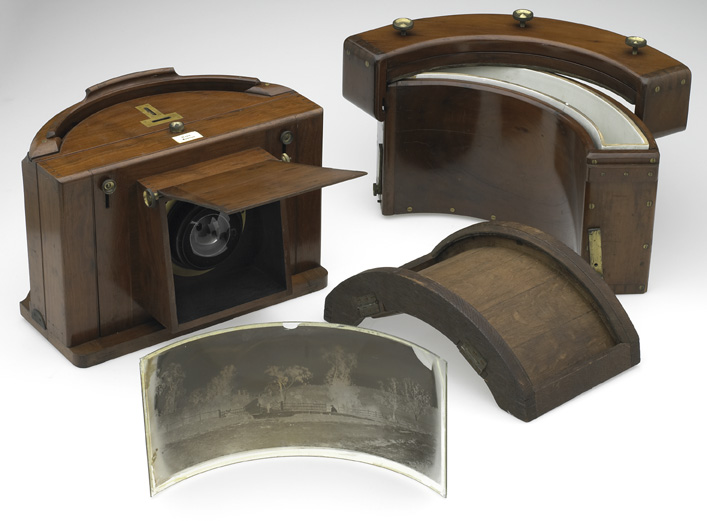Description
This is a panoramic camera, designed in England by Thomas Sutton, and one of about 30 produced. The camera lens is made up of two hollow glass hemispheres. The flap on the front of the camera lifts up to allow an image to be taken.
Educational value
- This was the first panoramic camera to use a wide-angle lens to capture a field of view wider than that of the human eye. In the late 1850s, British photographer Thomas Sutton (1819-75) invented this unique spherical water-filled lens to create panoramic pictures without the need to rotate a camera on its tripod and glue the images together afterwards.
- Most conventional cameras have an angle of view of about 40 to 55 degrees, which limits their ability to photograph large groups of people or landscapes, and Sutton's wide-angle lens represented a novel solution.
- This innovation in camera design increased the photographer's creative potential by making it possible to create panoramic images of subjects that were not static and to capture a more evocative landscape than was possible with a flat-plate camera. Panoramic photography was further revolutionised following the invention of flexible film in 1887.
- This camera achieved a panoramic effect by using curved glass plates and a hollow glass lens filled with distilled water giving an angle of 140 degrees. Some early panoramic cameras had and a butterfly-shaped diaphragm inserted into the centre of the lens to equalise the exposure over the whole angular field, although it is uncertain whether this camera had one.
- The blank plate was dipped in emulsion in the sensitising tank and the photograph was taken while the plate was still wet. Panoramic prints on paper were made from the glass negatives using a curved printing frame.
- Sutton was apparently inspired to create his liquid lens by a Victorian 'snowstorm' souvenir when he noticed that the images created by the curved glass surface when light passed through the water-filled sphere achieved the same effect as a wide-angle lens. Sutton's achievements also included the invention of the first reflex camera in the early 1860s and work on the development of dry photographic plates.
- Only about 30 examples of this innovative camera were ever produced due to the difficulties of manufacturing the model and its limited, specialised market. The cameras were initially manufactured in London by camera maker Frederick Cox in 1860, but he found manufacturing the water-filled lenses problematic and in the early 1860s the manufacturing was taken over by Thomas Ross. Ross improved the lens but his sales may not have been much better than Cox's. The London firm of Bland and Co advertised the camera until the firm closed down in 1864.
- This camera was used by Australian geologist and pioneering fieldwork photographer Richard Daintree (1831-78), who recorded images of the Victorian gold fields in the 1850s. Because of camera technology at the time, plates had to be exposed while wet and Daintree pioneered the use of cameras in the field by using a portable darkroom. Museum Victoria holds 12 curved glass negatives taken by Daintree.
